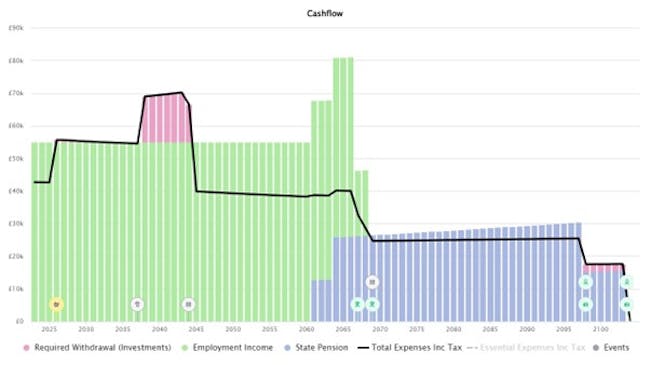Let’s move forward a few years now. It is 2031, and Joe, now aged 33, is living in the house he bought at age 30, along with his 30 year-old wife Jessie, a civil servant. Jessie has just returned to work after having baby Johnnie.
The couple are not happy with the quality of their local high school, and would like to send Johnnie to a private school from age 11. Clearly this is going to have quite an impact on their finances, and they will need to plan their cashflow carefully, not just through the years when they are paying school fees, but before then as well.
They know that they will need to put money aside during the next decade if they are going to be able to send Johnnie to their chosen school; however, they also need to reckon with the far-from-trivial matter of childcare costs before then as well, given that they will certainly need both incomes to achieve their goals.
And once again, they need to be
cognisant of the effect of reducing their saving for later in life in order to
meet those expensive school fees. While
Jessie’s civil service pension contributions will automatically continue while
she is working, Joe has to make a choice between how much he needs to save for
Johnnie’s school fees, and how much he can afford to make in pension
contributions given the family’s growing day-to-day costs.


The upper chart in Figure Two shows the shortfall if no advance planning is made to cover the school fees when they occur (the shortfall is shown in red). But looking at the years leading up to when Johnnie will go to school, the couple’s income is higher than their total expenses.
By putting that surplus into a savings plan, the forecast shows that the entirety of what is needed to cover seven years of school fees can be found without having to borrow, reduce other expenditure, or compromise the couple’s retirement planning.
Using the cashflow planning tool in this way can enable people to understand what they need to do now to achieve their future financial goals, and the impact on their financial wellbeing if they don’t undertake the actions they need to in advance.
In the next part, Joe and jessie contemplate retirement, and realise that every decision they have made so far will have an impact on their ability to enjoy their later years in relative comfort.
Read the next part in the series here.
To find out more about our personal cashflow modelling
Get in touchRelated news

Cashflow - It's not just for business
The rise of personal cashflow planning

Cashflow - Facing up to the consequence of illness
In part one, we looked at the concept of personal cashflow planning, and how it can help people map out their financial futures In this part, we look at what happens when an unforeseen event disrupts the plan.









